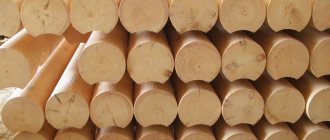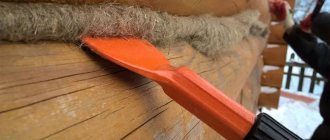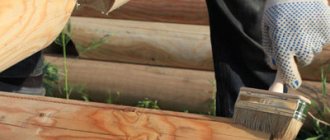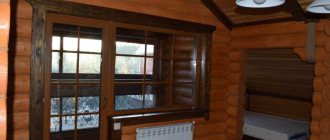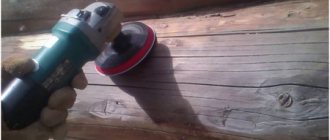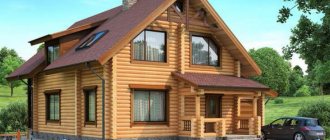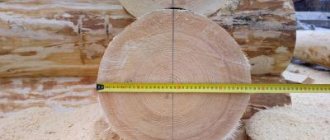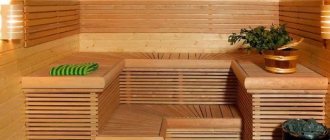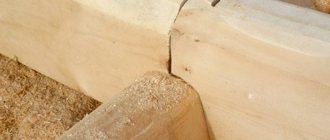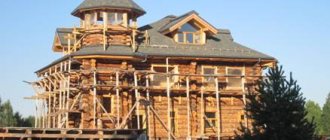The protruding ends of the logs are an important element of the entire structure, the protection of which requires special attention. Treating the end surface of log logs with special means can stop the negative impact of the environment. Timely measures will allow the wood to dry evenly, which will have a positive effect on the appearance of the building.
Why is it necessary to process the ends of logs?
Log cuts need additional protection, because first they crack, darken and change their natural shade to gray.
The reason for this is that the protruding end exposes the softest inner part of the tree.
Even in order to leave the log house in its natural state, the ends will still have to be treated with preparations. This is due to several reasons:
- Increased dampness. Open cuts are vulnerable to external factors. Longitudinal fibers absorb water more actively than transverse fibers, which is why this part of the log quickly becomes damp.
- The appearance of fungus. A large amount of moisture is the cause of mold. It softens the cut line, which is why the open ends rot and then crack.
- Uneven evaporation. Through saw cuts, moisture evaporates faster, this causes deep cracks and deformation of the crowns of the log house.
- The appearance of insects. Rapid evaporation of moisture contributes to the appearance of looseness. Because of this, the interior of the tree becomes vulnerable to temperature changes, and is also easily attacked by woodworms and other insect larvae that destroy it.
Treated ends slow down the evaporation of moisture and make this process more uniform. During shrinkage and shrinkage, the logs crack less, preserving the heat-insulating properties of the structure and its appearance.
Why is prevention needed?
After going through all the procedures at a timber processing plant, lumber in any form retains its natural ability to absorb moisture. Moreover, from the side of the once existing root system, this process manifests itself to a greater extent. This is one of the most important reasons for the need to protect the end part with preventative agents.
Impregnation of the log house is also carried out in order to slow down the aging of wood and cracking. There are compositions that “repel” insects feeding or living between the fibers or prevent the development of fungi and mold. Among other things, this prevents putrefactive processes and discoloration of surface layers under the influence of ultraviolet rays. That is, in total, it all comes down to maximizing the extension of the natural state of the lumber.
Source kraski-net.ru
What is better for processing
After identifying the cause of the problem, it is necessary to find ways to solve it. It is important to choose the right product to protect the ends of the timber so that they do not crack.
Sealant treatment
A wooden building will last longer if the end cuts are covered with a special sealant. It will seal existing cracks and prevent future cracking. After application and drying of the coating, a protective layer is formed on the surface.
The use of sealant does not require additional treatment of the wood with various antiseptics.
Thanks to the sealant, you can forget about cracks for a long time. It has the following effect:
- protects from excess moisture;
- reduces tension inside the log;
- Gently clogs pores while allowing the surface to “breathe.”
Dye
Another processing method is to coat the logs with paint.
The paint must be diluted with a solvent before application.
Using paint as an end putty:
- allows you to seal the timber, creating a surface protective layer;
- protects cuts from water and other external factors;
- ensures uniform evaporation of moisture;
- protects the surface from cracks.
Lime
Traditionally, lime was used to process saw cuts.
This natural antiseptic is distinguished by the fact that:
- disinfects the material and prevents the process of rotting;
- not afraid of UV radiation;
- has a relatively low cost.
However, this composition does not provide long-lasting protection and is quickly washed off by rain. The treatment will have to be repeated several times a year.
Experts advise using lime only for the first two years, and then using more reliable professional products.
Special processing agents
The modern construction market is filled with all kinds of coatings that protect wooden log houses well.
Biotor
Thanks to this solution, the deformation of the log is noticeably reduced.
The BIOTOR composition forms an elastic coating that is absorbed into the wood several centimeters, thanks to this:
- prevents the formation of rot;
- reduces the number of end cracks and their depth;
- helps remove excess moisture from wood;
- reduces wood deformation during drying.
Biotor retains its protective properties for a long time. This is a frost-resistant and fireproof material without solvents or odor.
After applying the antiseptic, the shade of the wood changes slightly, which allows you to control the untreated areas.
Neomid Thor Plus
The antiseptic creates an elastic, water-repellent coating with good vapor permeability, which allows the wood to “breathe.”
The coating has the following effects:
- protects wood from rotting;
- prevents the development and appearance of microorganisms;
- reduces linear deformation of timber during operation.
The resulting colorless film preserves the natural grain of the wood.
Senezh Tor
The product penetrates deeply into the wood and forms a reflective thick-layer elastic coating on the end surface, which normalizes the evaporation of excess moisture. In addition, this antiseptic:
- prevents cracking;
- protects against biological damage;
- does not affect the natural texture of the wood;
- provides reliable protection for several years.
The protective composition does not contain prohibited chemical compounds and is therefore safe for health.
Experts are against processing end cuts with the following folk remedies:
- machine oil;
- PVA glue;
- candle wax;
- varnish
They clog the pores of wood, disrupt air circulation and moisture exchange at the site of application.
Requirements for protective equipment
The first processing of the ends must be carried out immediately after the construction of the log house.
But since in the first years after construction there is an active process of shrinkage of the log house, it is necessary to treat the ends with a product that does not interfere with the natural shrinkage processes occurring in the wood. An antiseptic for the ends of a log house must have the following characteristics:
- do not interfere with the evaporation of moisture from the logs through the ends along the longitudinal fibers;
- do not suppress the processes of moisture removal through transverse fibers;
- do not interfere with the removal of moisture from the surface.
- protect wood from exposure to ultraviolet radiation;
- prevent rotting processes.
Processing technology
By adhering to a certain order of work, it is possible to protect the ends of logs, beams and other large-sized timber.
Processing of the ends of log logs takes place in several stages:
- Trimming is the alignment of all protruding logs to the same level in length and plumb. To do this, use a chainsaw or electric saw. Trimming adds aesthetics to the log house: all ends become smooth, without protrusions or burrs.
- Grinding the ends . Sanding helps prepare the surface for antiseptic treatment. In order for the protective layer to lay down better and more evenly, the end of the log must be smooth. The frame is sanded using a grinder or a belt sander. The surface is processed in two stages: the first - with a coarse abrasive, the final - with a fine one.
Sanding the material is carried out in dry weather conditions: processing wet wood will lead to the appearance of nicks and lint, which will not allow smoothness to be achieved.
- Application of a protective composition. The ends should be generously treated with a wide brush at least 3 times. Each new layer is applied only after the previous one has completely dried. Drying time of the layer is 24 hours at a temperature of 18-22°C.
When applying a protective coating, it is necessary to carefully process the edges of the end cuts. Treatment should only be carried out in dry, sunny weather.
How do you treat the ends of logs?
Dye
Special means
Torvens end oil and its features
For primary processing of log ends there is Torvens oil. The service life of its coating reaches 10 years. This has been confirmed by climate tests. Among the composition features:
- Resistance to precipitation.
- Wide temperature range. From -50 °C to +80 °C.
- Protecting wood from moisture, ultraviolet radiation, fungi and mold.
- Creates a breathable film, allowing moisture from the wood to evaporate.
- Quick and easy to apply.
- The surface of the ends does not crack or peel after treatment.
Torvens oil is suitable for decks, timber and other outdoor wood parts. Moreover, it can be updated without cleaning the surface. It is based on modified linseed oil, wax and antiseptic additives.
An example of competent processing of the end when it did not crack due to shrinkage
Silicone sealant for wood
Their qualities are somewhat superior to acrylic. Due to the presence of silicone, these sealing materials are much stronger and more elastic than their analogues.
In addition, they are able to withstand temperature changes and are resistant to deformation. Therefore, they are great for outdoor use. After the sealant has dried, you can apply a layer of oil paint to it.
protection and processing - necessity, types, work process
The most vulnerable point of logs is their ends. This is where the wood fibers fully open up to accept moisture and dry quickly. The ends of log logs, the protection and treatment of which were carried out incorrectly or at the wrong time, quickly crack and lose strength, and the cracks that appear become an attractive place for the development of mold and the activity of parasitic insects.
The need for end protection
Through cross sections, natural moisture retained in the wood after the tree is cut down comes out faster than from the sides of the trunk. If the ends are not covered in a timely manner, the shrinkage will occur unevenly. The contrast will be too significant - the wet inside of the trunk and the overdried ends. In addition to the cracks that appear, the log begins to bend, and the log house begins to warp. It is enough to look at materials lying for a long time in the open air to be convinced of the correctness of this statement. Without processing the ends:
- lose their natural color - quickly darken;
- become infected with a fungus - first black stripes and spots appear, and then mold;
- eaten by insects and rodents;
- quickly turn to dust.
And if ownerless logs can simply not be used in construction, then no one will dismantle the laid crowns until the log house finally becomes unusable. Preventive and planned measures will help extend the service life of a structure. Particular attention should be paid to the ends of the logs, the protection and treatment of which is carried out with means that do not impede the process of air exchange in the wood structure. This characteristic of the composition is very important, since when the natural outlet of moisture from the log is closed, it will begin to rot from the inside. You need to understand that the side of the trunk will not provide an opportunity for optimal disposal of internal dampness of the material.
Covering the ends of wood that has not yet completely dried with bitumen mastics is strictly prohibited.
What to process
In the rural outback, the log ends of the frame are coated with lime, which protects against moisture, mold, and insects. This is considered a classic option, but today it is used less and less. There are more modern domestically produced products on sale that are in no way inferior to their foreign counterparts. Is that their cost is somewhat lower and more affordable for most consumers.
We list some antiseptic agents that are intended for treating the ends of logs:
- BIOTOR - significantly reduces the formation of cracks, limits the impregnation of the ends with moisture, eliminates the curvature of fibers during the drying process of wood;
- NEOMID TOP PLUS – forms a thin, but integral, water-repellent and “breathable” film on the surface, emphasizes the texture of the wood cut, protects against rot, protects against fungal infection;
- SENEZH TOR - penetrates into the wood structure, allows air to pass through, but is a barrier to the penetration of moisture, prevents the appearance of cracks and mold, has a long active life, and practically does not change the natural color of the wood.
All of the listed compounds are environmentally friendly. They are certified and therefore do not contain prohibited and harmful components. Timely processing of the ends saves the log from uneven shrinkage, which implies a more stable shrinkage of the walls of a wooden house.
The process of protecting the ends of a log house
The first step, upon completion of the construction of the log house, is to trim the logs, aligning the protrusions of the parallel crowns in the same vertical plane. The work is carried out using a gas or electric saw. As a result, the facade takes on a neat, finished look, and the ends take on a smooth, well-groomed surface.
Crosscutting requires experience, a steady hand and maximum precision.
After aligning the ends, they begin to grind them, or clean up any irregularities. At this stage, they get rid of not only visual defects, but also dark spots that predetermine the appearance of fungal infection. The work uses a grinder or grinder equipped with a special attachment. Experts recommend grinding the ends only in dry weather, and after several sunny days. Relatively dry wood is easier to process, and a stretchy pile of wet fibers does not form on its surface.
After cleaning the ends from wood dust, impregnation is carried out. This process involves the application of a protective preparation that saves the logs from drying out too quickly and from insufficient drying. It is, as it were, a balancing regulator between the dryness and moisture content of the wood. The composition is applied with a wide brush in two times, allowing a time margin between layers to allow high-quality absorption of the drug into the structure of the log. The mixture must be smeared generously, without stretching, otherwise all efforts will be in vain. It should be understood that the end part of the log has a greater absorption capacity than its side surfaces. Taking into account this requirement, it is recommended to purchase the drug in reserve.
Additionally, the ends are treated with special “breathable” sealants. They are made on an acrylic base and are intended specifically for cross sections of wood. Each region has its own brands of similar products, so listing them is pointless. In the nearest construction supermarket, managers will be able to recommend the most popular sealant. But it would be better to ask for reviews from craftsmen working in a specific area. They can be easily found on the Internet.
semidelov.ru
Features of using wood sealants
In construction, sealants are used as a seal for walls. Professionals value it for its soundproofing qualities. However, the use of these tools has several disadvantages.
- Modern manufacturers offer a wide range of solutions with distinctive performance. Many of them can be used for fabric, remain flexible after drying, are resistant to environmental factors and are affordable.
- Sealing agents have many advantages over conventional seals, regardless of what type of sealant is used for finishing work.
- Among the advantages of simplicity and time of application with your own hands, we note the flexibility of the composition and, as a result, the attractive appearance of the wall, the correct fit of the seal, durability, and low visibility make this possible.
Therefore, the available instruments for filling intercoronal spaces have become familiar with their main characteristics. Let's take a closer look at what modifications are available on the market with various filling materials.
Why is there such attention to the ends of the log house?
The ends of the log house have a small area relative to the rest of the wood area. So why should you pay special attention to the ends?
Processing of the ends of the log house should be carried out immediately upon completion of the assembly of the structure. If you delay this, the results can be very disastrous.
Moisture penetration
The thing is that on the cross section, namely at the ends of the frame, in this case, the wood fibers are completely open. In this regard, any amount of moisture easily penetrates deep into the wood. Which will ultimately cause rot, mold and mildew. The wood at the ends begins to darken.
Wood cracking
Another undesirable consequence of not treating the ends of the frame will be cracking of the wood. Logs dry out unevenly along their length. Since the ends are open, moisture evaporates from them most actively. That is, the edges of the log become dry, but there is still a lot of moisture present in the center of the log.
As a rule, all this leads to cracking and changes in the geometry of the log. If the ends of the logs are processed, the moisture will evaporate more evenly. Along the edges and center of the log.
Decorative properties
In addition, processing the ends of the log house is necessary to protect the building. Both from external influences and to avoid cracking and warping of the log. The finishing of the ends of the log house also has a decorative role. Treated ends look much better than untreated ones.
Sealant for sealing joints in a house made of rounded logs
Wood is a delicate material, so to protect the wood it is recommended to choose a warm joint sealant for wood.
Acrylic sealants with high elasticity are suitable. Then, when the logs dry out, the composition will stretch along with the wood and will not damage the surface structure.
You can use acrylic-based sealant with cellulose and latex.
Penosil or Silwood are suitable for covering deep cracks in wood. For utility rooms, it is better to use a mixture of glue and sawdust.
“Penosil” is a two-component epoxy solution that glues not only wooden but also metal parts, is waterproof, does not leave streaks, and does not contain harmful solvents.
The advantage of the solution is that after hardening, the sealant can be given any shape, parts can be cut out, painted or varnished on the surface.
Contains modifiers, plasticizers, and coloring agents. It is recommended to sand the timber before coating.
“Sylwood” is a water-based acrylic solution, elastic, wood sealant suitable for interior work (optimum temperature to start work is + 10°C).
Pros and cons of sealing a log house
Despite the fact that old methods of insulation and sealing are still popular, sealants are gradually occupying a niche of primacy.
Which is not surprising, because sealant for exterior woodwork is non-toxic, protects against the growth of mold and mildew, withstands exposure to ultraviolet rays, and at the same time retains heat and allows air to pass through (wood “breathes”).
In addition, you don’t have to remove the old putty, but apply a new layer of sealant to the old one.
As for sealing with natural materials, caulking (clogging the seams with tow, linen and other materials) can cause insects or mold to multiply inside the timber - the reason is increased humidity.
This does not apply to moss - the plant is completely bactericidal and suppresses the development of microorganisms.
The downside is that natural materials are pecked by birds and collected fibers for nests. To ensure that the house is not left without protection, moss or tow must be painted or treated with special impregnations.
Technology for sealing inter-crown seams
Before you start working, you need to prepare the surface. Remove dirt and dust from the wood with a regular cloth. Cleaning dust with a rag is suitable for a newly built wooden house. Old wood can become moldy or blackened due to moisture or large amounts of resinous substances.
In this case, easy cleaning will not be enough. If the damage is deep, you need to remove the top layer of mold with a scraper and sand the surface with a sanding machine or sandpaper. It is recommended to remove the top layer if the wood has been treated with oil solutions.
Another method of sealing log seams is abrasive-jet, non-contact. Suitable for any wood. The surface of the tree is cleaned with a jet of sand and air under high pressure. The device removes the damaged layer from the timber, revealing a natural and clean pattern on the surface.
After sanding, be sure to treat the wood with special antifungal antiseptics and varnish.
The best impregnations for treating wooden surfaces:
- “Biosept” - impregnation not only destroys mold and mildew, but also removes “blue stains” from wood and protects against insects.
- “Senezh Ultra” – protects against mold and wood-boring insects. Do not apply to drying oil, paint, varnish and water-repellent solutions.
- “Pinotex Interior” is water-based and odorless – it forms a protective film that simultaneously masks minor defects. Does not leave streaks.
- “Tikurilla” is a semi-matte coating that can be mixed with other paints. Suitable for treating rooms with high humidity.
- “Rogneda Extra” - removes mold, mildew, blue stains, but takes a long time to dry and has a pungent odor.
- “Neomid” is a water-based impregnation that protects against pests and prevents the growth of fungus, but can color the wood pale green.
Sometimes grease stains appear on the wood. They can be removed with a solvent. After treatment, the timber is washed with water and a small amount of soap solution.
The next step is to apply inter-crown insulation between the seams. The material helps reduce gaps between logs. If there is no insulation between the seams, the timber will crack over time and the walls will freeze.
Intercrown insulation reduces the drying out of the wood, prevents moisture from penetrating inside, and prevents fungus from multiplying.
Inter-crown insulation can be replaced with bundles of foamed polyethylene.
The next step is to fill the deep gaps with foam (especially if the timber diverges greatly).
Applying sealant
To work you will need:
- Spray gun.
- Water.
- Rags.
- Paint brush (narrow).
- A narrow paint spatula (it is better to choose a rounded blade).
If you are going to apply wood joint sealant for the first time, start by treating the horizontal seams between the logs. Leave the timber joints for last.
Wipe the seam with a rag soaked in water. The rag should be damp, but not wet - drops of water should not flow down the frame, otherwise the adhesion to the surface will be impaired.
Check that no dirt or dust remains in the gaps.
Fill the construction gun with sealant, cut off the tip of the device (the cut angle should be no more than 45°C, and the diameter should not be more than 5 mm).
Wood sealant can be diluted in a separate bucket or a jar of solution can be attached to a syringe.
Press the tip of the spray gun close to the seam, and carefully squeezing out the composition, smoothly walk along the strip to the very end.
Don't rush - you don't need to release too much paste into the gaps (the thickness should be no more than 6 mm).
Smooth out the sealant strip. Pressure on the spatula should be light. If you press too hard, the layer will be too thin and may break after curing.
Excess solution must be removed with a rag before the sealant hardens. Some craftsmen remove the excess with a spoon and smooth the surface of the seam. Then use a rag to remove any rough edges from the seam.
The peculiarity of color compositions is that the shade is not immediately visible; you need to wait some time before it appears (usually no more than 10 days). During the first 4-5 days, it is important to ensure that the wood does not get wet.
Sealing seams and cracks
Cracks in wood appear for various reasons:
- Natural shrinkage of a log over time (usually seasonal).
- Mechanical deformations.
- Pressure on the beam.
Putty for filling cracks and chips can be one-component - based on one composition (usually alkyd), or two-component - when you need to mix putty and hardener. If the gaps are very deep, it is better to choose two-component compounds; they are more durable, flexible and do not shrink.
Wood glue and sawdust are used to cover small cracks.
You can repair cracks, chips and level the structure of wood with epoxy resin - once it hardens, the substance turns into plastic.
Cracks in logs need to be cleaned and all accumulated debris removed. The most effective cleaning method is a compressed air device (it is better to contact a cleaning company).
Place strips of masking tape along the edges of the cracks - this way, after removing the strips, the edges will remain smooth and the sealant will not come out beyond the seam.
Insert a thin strip of insulation inside the crack (depth up to 10 mm). Apply a layer of paste from a syringe on top of the strip, remove excess with a spatula (to easily remove excess, the spatula should be moistened in water).
Carefully remove the strips of tape.
It remains to wait until the solution hardens completely.
Restoration of potholes and chips is recommended to be carried out no earlier than 1-2 years after the construction of the house. The reason is that you need to wait until the house shrinks (cracks can expand several times).
Note: cracks up to 5 mm wide do not require repair.
Recommendations for the selection and use of sealant
You should not dilute the sealant for the log house with plain water; it may lose all its properties (delaminate and lose adhesion to surfaces).
Do not buy sealants weighing more than 340 g and with damaged packaging (frayed label, chips, dents).
Buying sealant in large containers will help save up to 15-20% of the solution, but provided that the paste is completely used.
20 liters of solution is enough to lubricate a maximum of 140-150 m of seams up to 2 cm wide, if the gaps are additionally covered with strips of insulation.
Do not trust the labeling - the inscription “100% silicone” most often indicates that the composition contains many additional impurities that negatively affect the quality of the material.
Acrylic-based compositions are not recommended for use for exterior decoration - they will not withstand low temperatures.
For covering wooden surfaces, it is better to choose colorless pastes.
To enhance adhesion to surfaces, before applying the paste, the seams are lubricated with a primer.
If moisture constantly accumulates in the room or is subject to high temperature changes, choose materials with fungicides in the composition (suitable for lubricating cracks on balconies and tiles in shower stalls).
For roofing, use bitumen pastes.
You should know that if the container with the solution is stored in cellars with sub-zero temperatures, the paste will be thick and will not adhere well to the seams.
It’s okay if the solution in plastic containers is frozen - it can be thawed at room temperature and used again. But do not speed up the defrosting process and do not place plastic buckets with the composition on hot heating pipes.
Bitumen sealant for wood
The simplest type of sealant, which is based on bitumen and rubber. It is most relevant for roofing work. Due to its composition, the sealing material does not dissolve in water.
This is why it has a high level of resistance and resistance to rain and moisture. This solution is very convenient to use and allows you to quickly deal with sealing cracks and seams.
- The only disadvantages that can be highlighted are that it is not suitable for painting, and at temperatures below 0 ⁰C, sealing bitumen material for wood is not recommended. The price of a 300 ml package is 380-390 rubles.
- The presence of sealed hydrocarbon solvents requires precautions. If work is carried out indoors, ventilation must be provided. Avoid contact with skin or eyes, use gloves, a respirator and special clothing for protection.
To eliminate cracks, it is advisable to take care of the heat conservation of the house and use a wooden seal.
Comments posted on this topic present it as the most advantageous material for fixing intervention seams, and thousands of houses built using this technology confirm the effectiveness of using sealing materials.
Impregnation mixtures
The processing procedure is carried out using various means that perfectly protect the wood and tend to repel large amounts of moisture:
- Use of impregnants and septic agents. Such mixtures perfectly protect wooden surfaces from the appearance of fungus, mold and various microorganisms. Such products are applied with a brush up to three times, each layer should dry for about 12 hours.
- Sealant - has the property of repelling water, does not allow the wood to rot, as it forms a film coating. Usually this product is coated up to two times.
- Machine oil is a cheap option for processing. Apply this oil in two layers, each layer dries for about 12 hours.
- Paints to which thinners are added perfectly protect the log from microorganisms and water, and therefore prevent fungus from developing.
- The use of lime is a very old method of treating logs; it prevents bugs from infesting and provides protection from water.
Acrylic sealant for wood
This is the most affordable and simple filling material. To work with it, no additional materials are required in the form of solvents and oxidizing agents. The composition is simply applied to the seams.
- A waterproof sealant that is environmentally friendly, resistant to high and low temperatures, and has excellent adhesion to the surface is preferred.
- Customer reviews indicate that choosing the right color material is quite simple.
- The only disadvantage of acrylic sealing material is instability under deformation loads.
Its demand in the building materials market is explained by its low price, which averages from 300 to 330 rubles, and this sealing material for wood can last for a long service life of up to 25 years.
How to apply Torvens oil correctly
Before applying, the oil must be carefully applied with a brush for 3-5 minutes. This will give it a uniform consistency. Then you need to do the following:
- Apply the composition evenly with a soft-bristled paint brush. In this case, the ambient temperature should be from +5 ° C to +35 ° C, the weather and the tree itself should be dry.
- Leave the first layer to dry for 8 hours.
- Apply the next layer 16-24 hours after the first has dried.
Torvens end oil for initial application gives a consumption of 1 liter per 14 m2. During application of the second layer, the consumption will be 1 liter per 8 m2.
